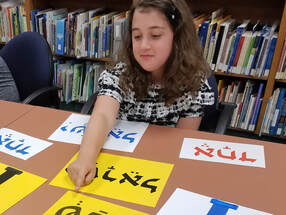 Are you "just curious"about #OnwardHebrew or are you ready to initiate a change process in your educational program? No matter your answer, the relatively concise list of curated resources, below, will help you more easily gather background information and begin plotting your change process: This is a blog post that offers a pretty comprehensive (but quick!) overview of #OnwardHebrew. Of special interest is a chart towards the end that shows in one synagogue the impact on decoding of less years and less hours for Hebrew learning in a synagogue setting (spoiler alert – the learners did just as well with fewer total years and hours!). This is the video that got #OnwardHebrew started - it explains why we have been having issues with Hebrew learning in part-time/synagogue settings. This video is a good conversation starter for faculty, committee members and parents. Much has happened in the world of Hebrew learning since it was created (2013), but its foundation is still solid. This is a webpage with targeted resources for learning about each of the elements of #OnwardHebrew. All are videos, some are webinar-length and others are shorter. For links to many more resources, click on any of the icons on this webpage. This is a "getting started" booklet that offers background on #OnwardHebrew for those who have been curious about the initiative, but not sure where to begin. A special feature is the use of QR codes for those who want more info on a topic than is on the page. This is our blog. All the postings are relatively short and help you gain a broader understanding of #OnwardHebrew. There are a number of postings that would open conversation among stakeholders. This offers an interesting set of reactions to #OnwardHebrew implementation by education directors who have taken on the initiative in their own program. They talk about successes, as well as challenges. This is an article that explores the question of why an educational program might change the grade level in which it teaches decoding. In a traditional Hebrew program, children are introduced to Hebrew decoding in third or fourth grade. However, one of #OnwardHebrew’s innovations is moving the teaching Hebrew decoding to fifth grade or later, after children have built a repertoire of Hebrew sounds and vocabulary. [Feel free to check out this decoding resource developed for #OnwardHebrew's older learners called Let's Learn Hebrew Side-by-Side. In a one-on-one setting, children quickly and easily build decoding skills working sound-to-print.] That said, teaching decoding later is not a requirement for #OnwardHebrew participation; currently, about half of the #OnwardHebrew programs have not shifted their grade level for teaching decoding. NOTE: The decoding article linked here is one of many blogposts on the #OnwardHebrew website, most of which would make for interesting reading and conversation with faculty, clergy and volunteer leadership. Scroll through to see what else interests you!] This is the recording of an American Conference of Cantors webinar with Cantor Leigh Korn (previously the head of the ACC) and Rabbi Nicki Greninger - they are both at Temple Isaiah in Lafayette, CA and have worked for years with #OnwardHebrew's philosophy and elements. Your cantor or clergy team may find this a helpful resource. These are the results of a survey done in summer 2019 with the congregations involved in #OnwardHebrew at the time. Results are in infographic form and may be of use to you, your committee, and possibly teachers. This is a list of assumptions for teaching Hebrew in the 21st century - it would make for good discussion with your committee and/or teachers. This is an edited video of Simon Sinek’s “Start with Why” TedTalk. A good place to begin a change process is to consider “why Hebrew” … like, why is Hebrew important to your host institution or educational program? As Simon Sinek says, “People don't buy what you do; they buy why you do it. And what you do simply proves what you believe.” So what are your bigger purposes to Hebrew learning and use? Your “why statement” will provide a touchstone for continued conversation and course correction over the years. Click here and here for some thoughts on why Hebrew. Finally, while this may seem like a bit of a non sequitur, it’s a helpful resource for those involved in a change process. If you are the kind of educator who likes to start meetings with text study, the Experiment in Congregational Education (ECE) assembled some great Jewish text study resources for change processes. You’ll find them here. A caveat: In many, the Hebrew font used appears in an unintelligible symbol-font – if you wish to use the Hebrew (of course you do!) you may need to grab a printable version of each text from a resource like Sefaria. ## So, are you ready to explore or are you ready to start? #OnwardHebrew is here to help. Please post your comments, questions and additional resources below and/or on the #OnwardHebrew Facebook group. Also, let me - Nachama Skolnik Moskowitz ([email protected]) - know that you are dipping your toes in the #OnwardHebrew waters. I would be happy to offer supports along the way!
0 Comments
Your comment will be posted after it is approved.
Leave a Reply. |
AuthorSAll of us! If you have something to contribute, send your posting via the Contact webpage! Archives
September 2023
Categories
All
|
 RSS Feed
RSS Feed